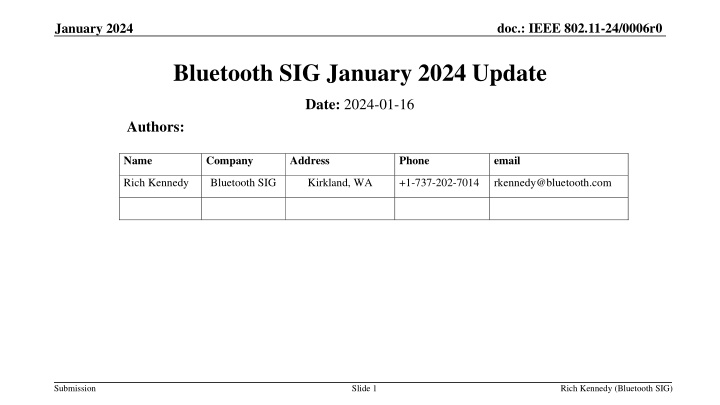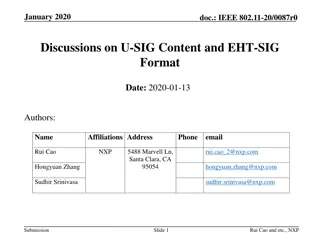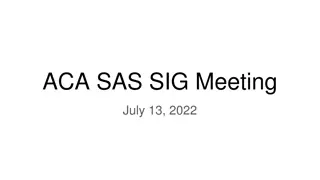Update on Bluetooth SIG's Plans for Spectrum Sharing in January 2024
Bluetooth SIG presents an update on their actions and plans for sharing the 5 and 6 GHz bands with incumbents and unlicensed devices. Recognizing the need for future growth, they aim to collaborate with the Wi-Fi industry to develop optimal sharing mechanisms in the 6 GHz band. Their plan includes creating an industry coalition, collaborating with SDOs, and driving regulatory and standards changes to facilitate equitable spectrum sharing.
Download Presentation

Please find below an Image/Link to download the presentation.
The content on the website is provided AS IS for your information and personal use only. It may not be sold, licensed, or shared on other websites without obtaining consent from the author.If you encounter any issues during the download, it is possible that the publisher has removed the file from their server.
You are allowed to download the files provided on this website for personal or commercial use, subject to the condition that they are used lawfully. All files are the property of their respective owners.
The content on the website is provided AS IS for your information and personal use only. It may not be sold, licensed, or shared on other websites without obtaining consent from the author.
E N D
Presentation Transcript
doc.: IEEE 802.11-24/0006r0 January 2024 Bluetooth SIG January 2024 Update Date: 2024-01-16 Authors: Name Company Address Phone email Rich Kennedy Bluetooth SIG Kirkland, WA +1-737-202-7014 rkennedy@bluetooth.com Submission Slide 1 Rich Kennedy (Bluetooth SIG)
doc.: IEEE 802.11-24/0006r0 January 2024 Abstract This is an update on Bluetooth SIG actions and plans for sharing the 5 and 6 GHz bands with incumbents and unlicensed/license- exempt devices. Submission Slide 2 Rich Kennedy (Bluetooth SIG)
doc.: IEEE 802.11-24/0006r0 January 2024 Agenda Bluetooth Sharing Goals The Overall Bluetooth SIG Plan Recent Actions ETSI BRAN #120 New Work Item; BRAN #123 Bluetooth Next Steps Submission Slide 3 Rich Kennedy (Bluetooth SIG)
doc.: IEEE 802.11-24/0006r0 January 2024 Bluetooth Sharing Goals The Bluetooth SIG recognizes the contribution the Wi-Fi industry has made in opening the 6 GHz band for unlicensed/license-exempt sharing to grow the technology Today, Bluetooth technology needs to secure its future growth The 83.5 MHz of the 2.4 GHz band is not a sufficient hedge against congestion or sufficient to support innovation Bluetooth and Wi-Fi successfully shared the 2.4 GHz band for many years Unfortunately, most of 5 GHz is not viable for Bluetooth, i.e., indoor restrictions and DFS 5.8 GHz band available in many regulatory domains Narrowband technology already deployed in U-NII-3 The 6 GHz band has room for Bluetooth and Wi-Fi, and there is time to develop optimal sharing mechanisms We will work closely with the Wi-Fi industry in IEEE 802 and Wi-Fi Alliance to enable Bluetooth sharing these band equitably Submission Slide 4 Rich Kennedy (Bluetooth SIG)
doc.: IEEE 802.11-24/0006r0 January 2024 The Overall Bluetooth SIG Plan Create an industry coalition of Bluetooth companies to drive regulatory and standards changes just as Wi-Fi did Including companies with both Wi-Fi and Bluetooth businesses Collaborate with Wi-Fi industry to drive needed changes Work with SDOs to develop optimum spectrum sharing methods and advance regulatory/standards to codify them as required ETSI BRAN New Work Item adopted in September 2023 (BRAN #120) The detailed plan can best be developed working together Now that the FCC has completed the first round of VLP decisions, we are requesting another for narrowband sharing (without geofencing) Chairwoman Rosenworcel said there will be a number of additional NPRMs Submission Slide 5 Rich Kennedy (Bluetooth SIG)
doc.: IEEE 802.11-24/0006r0 January 2024 FCC 23-86 Second Report and Order VLP Power Levels and Protection of Incumbents Bluetooth SIG: Support Wi-Fi conclusions on VLP power and PSD limits (14 dBm and 1 dBm/MHz); narrowband less likely to cause harmful interference CBP for protection of BAS and CARS not a concern for U-NII-5 Second Further Notice of Proposed Rulemaking Power Limits for Geofenced VLP Devices in the U-NII-5 through U-NII-8 Bands Bluetooth SIG: Currently, Bluetooth does not natively have geolocation capability, but can share in multi-radio devices via coordination with GPS Narrowband operation may not pose harmful interference threat without geofencing Submission Slide 6 Rich Kennedy (Bluetooth SIG)
doc.: IEEE 802.11-24/0006r0 January 2024 FCC 23-86 [2] Memorandum Opinion and Order on Remand NAB request for dedicated 6 GHz spectrum for mobile services Bluetooth SIG: BAS and CARS only in U-NII-6 and U-NII-8, where Bluetooth has no current interest Submission Slide 7 Rich Kennedy (Bluetooth SIG)
doc.: IEEE 802.11-24/0006r0 January 2024 European Commission Directive on VLP Provisions Parameter Technical Conditions Note 1: The mean e.i.r.p. refers to the e.i.r.p. during the transmission burst which corresponds to the highest power, if power control is implemented. Indoors and outdoors. Use on Unmanned Aircraft Systems (UAS) is not permitted The VLP device is a portable device 5 945-6 425 MHz Permissible operation Category of device Frequency band Note 2: Narrowband (NB) devices are devices that operate in channel bandwidths below 20 MHz. NB devices also require a frequency hopping mechanism based on at least 15 hop channels to operate at a value of in-band power spectral density (PSD) above 1 dBm/MHz. Maximum mean e.i.r.p. for in-band emissions (note 1) Maximum mean e.i.r.p. density for in-band emissions (note 1) Narrowband usage maximum mean e.i.r.p. density for in-band emissions (note 1) (note 2) Maximum mean e.i.r.p. density for out-of-band emissions below 5 935 MHz (note 1) 14 dBm 1 dBm/MHz Note 3: The appropriateness of this limit shall be subject to review by 31 December 2024. In the absence of justified evidence, a value of -37 dBm/MHz shall apply from 1 January 2025 10 dBm/MHz - 45 dBm/MHz until 31 December 2024 (note 3) Techniques to access spectrum and mitigate interference that provide an appropriate level of performance to comply with the essential requirements of Directive 2014/53/EU shall be used. Where relevant techniques are described in harmonised standards or parts thereof the references of which have been published in the Official Journal of the European Union in accordance with Directive 2014/53/EU, performance at least equivalent to the performance level associated with those techniques shall be ensured. Submission Slide 8 Rich Kennedy (Bluetooth SIG)
doc.: IEEE 802.11-24/0006r0 January 2024 ETSI BRAN New Work Item Provisions (1) To develop a channel access mechanism for Narrowband Frequency Hopping equipment operation (2) To develop mechanisms enabling LPI client-to-client operations in accordance with ECC/DEC/(20)01 and EC Decision 2021/1067 on 6 GHz WAS/RLANs (3) To consider further development of FBE and LBE parameters for channel access mechanism (4) To consider inclusion of new channelization to support next generation technologies (bandwidths exceeding 160 MHz, e. g. 320 MHz) Submission Slide 9 Rich Kennedy (Bluetooth SIG)
doc.: IEEE 802.11-24/0006r0 January 2024 Recent Actions Work on consensus response to FCC 23-86 Second FNPRM Referencing the EC Directive and SE45/FM57 conclusions for narrowband VLP Continued review of sharing simulation results Began discussion of acceptable limits Submission Slide 10 Rich Kennedy (Bluetooth SIG)
doc.: IEEE 802.11-24/0006r0 January 2024 Bluetooth Next Steps Pursuing FCC FNPRM follow-on for narrowband VLP NPRMs Participating in and contributing to the ETSI BRAN development of narrowband channel access mechanisms in 6 GHz ETSI BRAN #123 February 2024 Exploring enhanced sharing mechanisms for the 5725 5850 MHz band Further regulatory action needed on the 5.8 GHz band globally China: Bluetooth type-approval requirements Japan: 5.8 GHz band limited by DSRC Road Tolling can VLP share? Submission Slide 11 Rich Kennedy (Bluetooth SIG)























